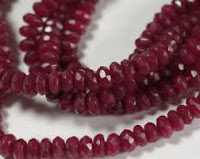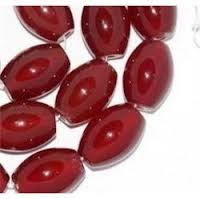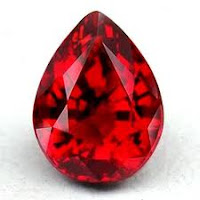General
and Scientific Details of the Ruby gemstone
 |
| www.jordansjewelrydesigns.com |
A ruby is a pink to blood-red colored gemstone, a variety of
the mineral corundum (aluminium oxide). The red color is caused mainly by the
presence of the element chromium. Its name comes from ruber, Latin for red.
Other varieties of gem-quality corundum are called sapphires. The ruby is
considered one of the four precious stones, together with the sapphire, the
emerald, and the diamond.
Prices of rubies are primarily determined by color. The
brightest and most valuable "red" called pigeon blood-red, commands a
large premium over other rubies of similar quality. After color follows
clarity: similar to diamonds, a clear stone will command a premium, but a ruby
without any needle-like rutile inclusions may indicate that the stone has been
treated. Cut and carat (weight) are also an important factor in determining the
price.
Rubies have a hardness of 9.0 on the Mohs scale of mineral
hardness. Among the natural gems only moissanite and diamond are harder, with diamond
having a Mohs hardness of 10.0 and moissonite falling somewhere in between
corundum (ruby) and diamond in hardness. Ruby is α-alumina (the most stable
form of Al2O3) in which a small fraction of the aluminium3+ ions are replaced
by chromium3+ ions. Each Cr3+ is surrounded octahedrally by six O2- ions. This
crystallographic arrangement strongly affects each Cr3+, resulting in light
absorption in the yellow-green region of the spectrum and thus in the red color
of the gem. When yellow-green light is absorbed by Cr3+, it is re-emitted as
red luminescence. This red emission adds to the red color perceived by the
subtraction of green and violet light from white light, and adds luster to the
gem's appearance. When the optical arrangement is such that the emission is
stimulated by 694-nanometer photons reflecting back and forth between two
mirrors, the emission grows strongly in intensity. This effect was used by
Theodore Maiman in 1960 to make the first successful laser, based on ruby.
All natural rubies have imperfections in them, including
color impurities and inclusions of rutile needles known as "silk".
Gemologists use these needle inclusions found in natural rubies to distinguish
them from synthetics, simulants, or substitutes. Usually the rough stone is
heated before cutting. Almost all rubies today are treated in some form, with
heat treatment being the most common practice. However, rubies that are
completely untreated but still of excellent quality command a large premium.
Some rubies show a three-point or six-point asterism or
"star". These rubies are cut into cabochons to display the effect
properly. Asterisms are best visible with a single-light source, and move
across the stone as the light moves or the stone is rotated. Such effects occur
when light is reflected off the "silk" (the structurally oriented
rutile needle inclusions) in a certain way. This is one example where
inclusions increase the value of a gemstone. Furthermore, rubies can show color
changes—though this occurs very rarely—as well as chatoyancy or the "cat's
eye" effect
Generally, gemstone-quality corundum in all shades of red,
including pink, are called rubies.However, in the United States, a minimum
color saturation must be met to be called a ruby, otherwise the stone will be
called a pink sapphire. This distinction between rubies and pink sapphires is
relatively new, having arisen sometime in the 20th century. If a distinction is
made, the line separating a ruby from a pink sapphire is not clear and highly
debated.As a result of the difficulty and subjectiveness of such distinctions,
trade organizations such as the International Colored Gemstone Association
(ICGA) have adopted the broader definition for ruby which encompasses its
lighter shades, including pink
Healing,
Magical,and Mystical Properties
Rubies and ruby jewelry throughout time have been said to
have many positive effects and mystical properties. The ruby is associated with
the sun, and was thought to preserve mental and physical health. In the middle
ages, rubies were viewed as a stone of prophecy. It was thought the stone
darkened when danger was near. Ivan the Terrible of Russia stated that rubies
were good for the heart, brain and memory. A Thirteenth Century prescription to
cure liver problems called for powdered ruby. In the 15th-16th Centuries,
rubies were thought to counteract poison. When rubbed on the skin, they were
also thought to restore youth and vitality.
For thousands of years, Ruby was considered the stone of
love, energy, passion, power, and a zest for life. Like no other gemstone in
the world, Ruby is the perfect symbol for powerful feelings. The other
important element of Ruby besides fire is blood, and Ruby is said to restore
vital life forces and increase energy and vigor. Ruby is also known as the
stone of courage, and legend tells us that a person possessing a ruby can walk
through life without fear of evil or misfortune.
Physically, rubies are thought to energize and balance,
stimulate heart chakra and encourage a passion for life, but never in a self
destructive way. They overcome exhaustion and calm hyperactivity. They detoxify
the body and blood, and treat fevers, diseases, and restricted blood flow. They
are good for the heart and circulatory system and stimulate the adrenals,
kidneys, reproductive organs and spleen.
Emotionally, it is believed that rubies improve motivation
and the setting of goals. They promote positive dreams and clear visualization
and aid in retaining wealth and passion. They bring up negative anger in order
for change and removal. They also promote dynamic leadership. They bring a
positive and courageous state of mind- one that is sharp, hyper aware and
concentrated. They make you stronger during times of controversy or dispute and
shield against physical attack. A ruby is also said to be a settler of
disputes, having the power of reconciliation. A ruby is dynamic, and brings
about passion and enthusiasm, attracting sexual activity.
Any jewelry that carries a Ruby signifies so much passion
and love between two people, that it makes Ruby an ideal choice for engagement
or Valentine’s Day jewelry. Furthermore, Ruby is the gemstone to be given on
the 15th and 40th wedding anniversaries.
The uplifting and vital nature of Ruby is an encouragement
to live fully, and embrace the joy of life that is missing in many people's
lives. Ruby allows the fire of passion and love to advance. It helps to bring
down the walls we build around us to keep others out.
The ruby is quite certainly a wonderful gemstone for
bringing fire into your life. For if you like to live your life intensely, but
often find it difficult to keep focus, a ruby can help bring clarity and wisdom
to your world. Instead of flitting from idea to idea, this gemstone will very
well help you choose your most productive paths. With it's power, this gem will
then fire your passions and keep you motivated. You'll be stronger when
resisting self-destructive pattern that have crippled you in the past!
The ruby provides and incredibly power shield against
harmful intentions. If you are caught up in a sticky legal dispute or personal
conflict of some kind, this gemstone can aid you in manifesting the correct
outcome. This gemstone can also guard you against psychic or physical attack.
One ancient tradition suggests that a 'ruby blessing' will
protect your garden from violet spring storms, as well as blessing the four
corners of your garden with the ruby should prevent damage from wind, rain,
hail and blowing debris.
Sleeping with a ruby will help promote lucid dreaming,
allowing your conscious mind to interact with your subconscious mind. Together,
you can confront your demons and uncover the means to defeat them.
On the other hand, dreaming of rubies, may be a sign of an
opportunity or money coming your way!
The ruby may be most beneficial in stimulating the adrenal
gland, as well as improving circulation and fighting internal infections.
Energy: Projective ,Element: Fire -Deities: Buddha, Krishna
(not to be confused with the modern expression of the Krishna-centered
reverence) .Powers: Wealth, protection, power, joy, anti-nightmare
Working with this stone can remove all sense of limitation.
Strengthens courage, selfless work, all spiritual endeavors, joy and many
leadership qualities. Ruby helps to reduce resentment when you are required to
care for others.
The ruby can create a strong sense and means of power within
a person; this power should be handled responsibly or it may turn into anger
and possessive thoughts.
Ruled by Mars, the gemstone ruby is worn during magical
rituals to increase the inherent energies that are available to the magician,
or it is placed on the altar beside a red candle to lend energy when feeling
depleted or drained.
In a similar line of magical influence, wearing a ruby is
said to increase the warmth of the body.











































